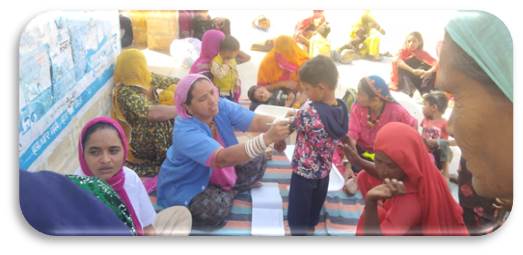Detail of the Initiative/work :
This innovation was initiated to screen approx. 1.23 lacs children of age group 0-5 years (which includes children registered at AWC and children not availing ICDS services) using growth measuring devices and MUAC tape and treating them at MTC (Malnutrition Treatment Centers) or community based malnutrition management program as per need. Screening camps were organized across 862 villages of all 7 blocks and 2 urban local bodies with coordination of ICDS, Medical & Health and Panchayati Raj under guidance and direction of District Collector.
|
Category |
NFHS-5 |
NITI Indicator JAN 2021 |
|
|
Rajasthan |
Jaisalmer |
||
|
Underweight |
27.60% |
31.70% |
17.32% |
|
Stunted |
31.80% |
25.50% |
17.85% |
|
SAM |
7.60% |
13.80% |
3.28% |
|
MAM |
16.80% |
25.00% |
8.67% |
The
5th round of NFHS, found that prevalence of underweight, stunted and
wasted children under 5 years in Jaisalmer was 31.70, 25.50 and 38.80 percent.
Wasting is the most immediate, visible and life-threatening form of malnutrition. It results from the
failure to prevent malnutrition among most vulnerable children.
Children
with wasting are too thin and their immune systems are weak, leaving them
vulnerable to developmental delays, disease and death. Some children affected
by wasting also suffer from nutritional oedema, characterized by a swollen
face, feet and limbs. When efforts to prevent malnutrition fall short, early
detection and treatment of children with wasting and other forms of
malnutrition are critical to save their lives and put them on the path to healthy
growth and development.
Due
to large number of vacant posts of supervisors, absence of required educational
qualification of AWWs and ASHA and dispersed population of district residing in
hard to reach villages and hamlets, growth monitoring was not effective. At
same time there is discrepancy between NFHS-5 data and NITI indicators progress
report of the district. On these basis this initiative was taken up.
Implementation of the intervention :
This involves convergence of ICDS, Medical & Health, Education, Rural Development and NGOs. Initially awareness about the program was created at village level in rural areas and at ward level in urban areas and then on MCHN days camps were organized regularly at aanganwadi centers across the district.
In the month of February ,after growth measuring devices were delivered in the district, a district wide campaign for anthropometric measurement of children of0 to5 years age group taken up .In this campaign at first nutritional level of children was measured by ASHA workers with help of MUAC tape and simultaneously height and weight were measured by AWWs. Both ASHA Workers and AWWs worked under supervision of their supervisors and ANMs. To ensure that maximum children are screened, Panchayati raj, Revenue and Education Departments were also involved to motivate parents to bring their children at AWCs for screening. Out of estimated 1.23 lacs children of this age group,71447 children were measured in month February 2023 and 637 children were identified as SAM ,out of which 7 children were admitted in MTC in month of March . Remaining 41% children are also being screened currently and the whole survey would be completed by April. In the past one year 17 children were admitted in MTC and have been brought out of the malnutrition category.
Output and outcome of the initiative/intervention & Impact on beneficiaries : In the month of February, camps were organized at all AWCs jointly by ICDS and medical teams. In these camps out of approx. 1.23 lacs children expected to be measured ,71447 children were screened.
These 637 SAM children were registered under Acute Malnutrition Management Action (AMMA) program.




Comments 0 Like 2 Dislike 0